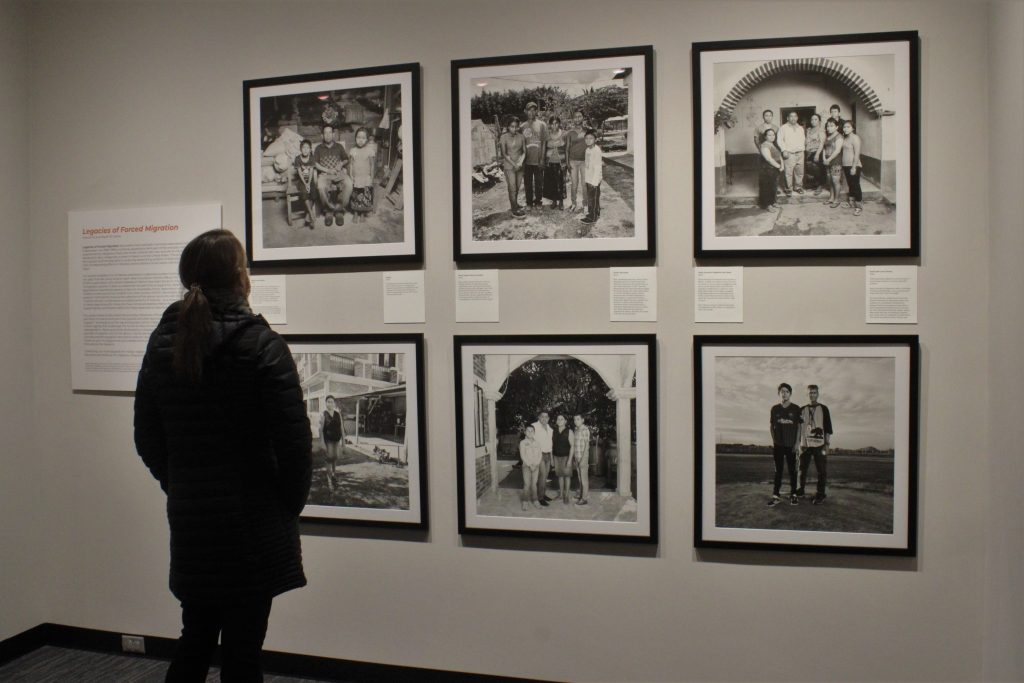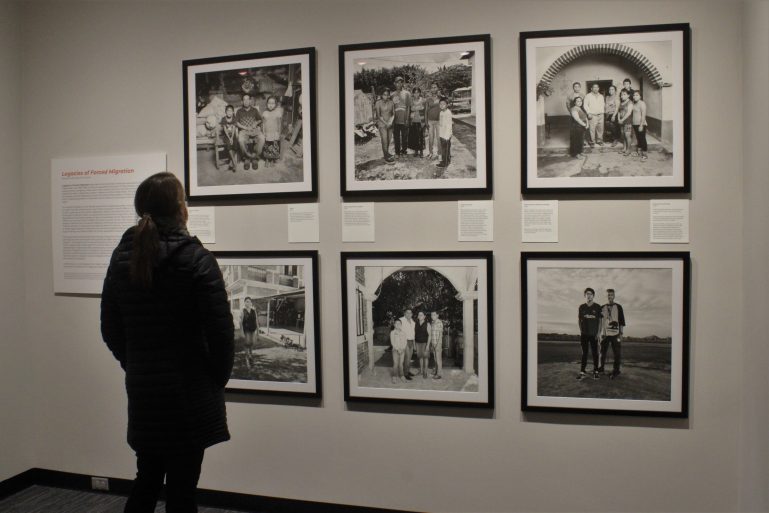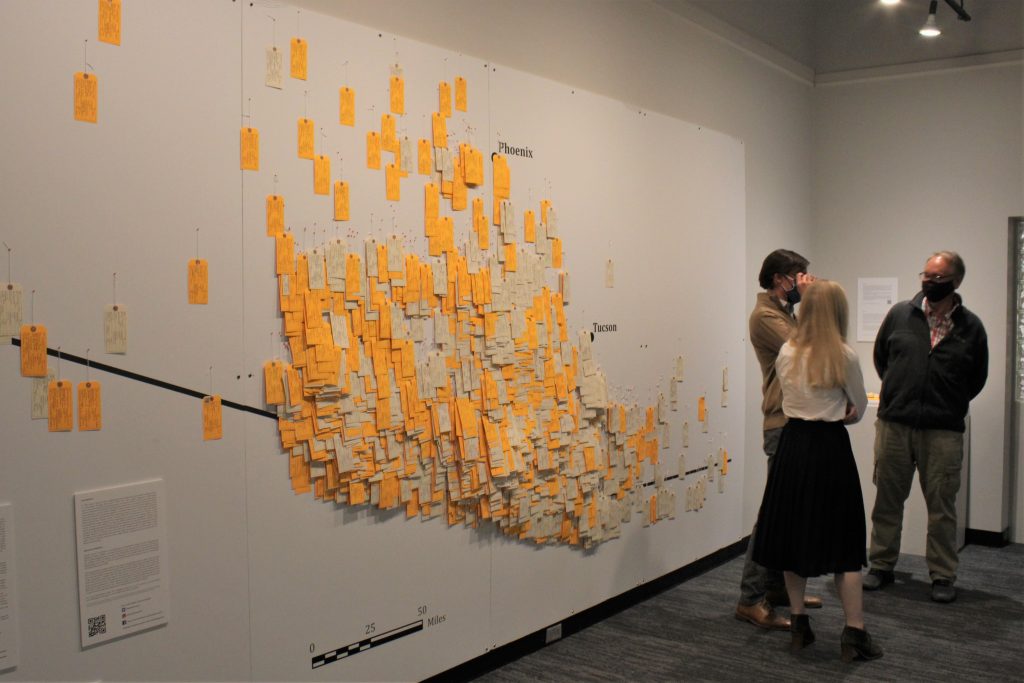
“Hostile Terrain 94” and “Legacies of Forced Migration” debuted at the Roberson Museum and Science Center on Friday, Oct. 1. “Hostile Terrain 94,” the aforementioned map, pinpoints locations where migrant bodies have been found between the years 2000 and 2020 in the Sonoran Desert region of the United States-Mexico border. Tags documenting causes of death and basic personal information hang from these points. Yellow manila tags represent identified bodies, while orange tags represent unidentified individuals.
“Hostile Terrain 94” is a project sponsored by the Undocumented Migration Project, a nonprofit organization led by University of California Los Angeles (UCLA) anthropologist Jason de León that researches and educates people on unauthorized immigration and the violence and dangers that migrants face. The “Hostile Terrain 94” map was originally hung in the Fine Arts Building on Binghamton University’s campus in the fall of 2020. Most of the tags were filled out by BU students, who were invited to do so at a public event last fall. This map is one of 94 installations in different global locations, all of which debuted simultaneously in the fall of 2020 due to the effort of volunteers and students at various universities.
David Mixter, a professor of anthropology and environmental studies at BU, introduced the exhibition, and Ana Sanchez-Bachman, a Ph.D. candidate studying anthropology at BU, explained the geographic significance of the diverse and extreme landscapes masked by the flat, white nature of the map.
Bachman pointed to the eastern side of the map, underneath Tucson, and described the higher elevation, trees and weeds in the area, as well as the wet climate. Bachman explained that this is considered the “more expensive, and slightly easier route, compared to the west desert … [which has] flat plains, volcanic lava fields and mountain chains cutting through.”
When migrants choose to take the cheaper, frequently used route through the west desert, they frequently have run-ins with drug cartels, who force migrants to carry contraband to pay for their passage. There is also an active bombing range in the area — self-explanatory in terms of the dangers it presents. Under cause of death, many of the tags read “gunshot,” “dehydration” and “overexposure,” but many bodies were found so damaged or decomposed that the cause of death was unidentifiable.
“The desert is not an inherently malevolent space and the loss of life here was entirely preventable, but it’s important to consider the diversity of experiences here, and to consider the landscape itself and how it has been turned into a graveyard in this area,” Bachman said.

The exposure, dehydration and violence in southern Arizona that caused the deaths of the roughly 3,200 people tagged on the map were mostly the result of 1994 U.S. immigration policies known as “prevention through deterrence” strategies. The enforcement strategy aimed to lessen migration across the U.S.-Mexico border by closing off frequently used crossing points, forcing migrants to take the more dangerous and deadly path and trek through the previously mentioned regions, or “hostile terrain,” as the Border Patrol called it.
In the foyer of the exhibition and across the “Hostile Terrain 94” map in the main room, viewers see the faces of survivors in the beautiful and haunting photos that make up Oscar Gil-Garcia, assistant professor of human development and distinguished visiting scholar at the University at Buffalo’s Center for Diversity Innovation, and Manuel Gil’s exhibition, “Legacies of Forced Migration.” This exhibition, juxtaposed with the “Hostile Terrain 94” map, represents Indigenous Maya in the former refugee settlements of La Gloria, Nueva Libertad and San Francisco, who fled their homes in Guatemala during the civil war that lasted from 1960 to 1996, resulting in over 250,000 deaths. The community of La Gloria lies at the center of Gil-Garcia’s ethnographic research at BU. His brother, Manuel Gil, is the artist behind the photos.
The project explores the displacement of Guatemalan peoples which has resulted from the combination of hostile Mexican and U.S. immigration policies. Currently, 27,000 Guatemalans are stateless in Mexico and have been forced to move to the United States. Gil and Gil-Garcia helped their subjects, 26 petitioners in all, obtain legal status in Mexico by collaborating with community leaders to pressure the Mexican state.
Gil-Garcia and Gil wanted to portray Indigenous Maya, who have faced tremendous oppression by the U.S. and Mexican governments, as well as invasions of their settlement at La Gloria, as dignified rather than vulnerable. The photos are coupled with plaques that tell brief stories about the subjects — stories of immigration, attack, displacement and triumph.
“These survival narratives compelled us to search for a decolonial counter-optics that shift the agency away from an external camera holder to the migrants themselves,” Gil said.
Rather than depicting the violent, painful scenes the “hostile terrain” map alludes to, Gil captures his subjects in dignified, humanizing poses — seated in front of the camera or standing with family. Film photography was the chosen medium to represent these people purposefully. The tangibleness of a photograph is something that Gil and Gil-Garcia felt was important to give their subjects a sense of agency and possession. They gifted their subjects the initial test Polaroids they took to keep, and after a year or two of developing and finalizing the photos, sent copies of the displayed photos to the families.
“These individuals are fighting for survival in a world that increasingly attempts to take away their possessions, anything that is material, such as their lands, their homes, their documents, even their families,” Gil said. “The use of film attempts to oppose this practice by creating something material that gives back.”
In collaboration, the “Hostile Terrain 94” and “Legacies of Forced Migration” exhibitions create a powerful juxtaposition. While the map focuses on the violent deaths and injustices immigrants have faced crossing the U.S.-Mexico border through documenting found bodies, Gil-Garcia and Gil portray beautiful Mayan people in their homes and with their families. However, the exhibitions tell parallel narratives. Although not directly depicted, hostile immigration policies and traumatic experiences fleeing the Guatemalan War continue to affect Gil and Gil-Garcia’s subjects. These narratives are also not isolated — the United States has a long history of enforcing aggressive immigration policies.
“Despite the absence of scientific data that shows deterrence measures as effective strategies to prevent future migration, we have seen the spread of these practices recently under the Trump administration’s zero tolerance policy,” Gil-Garcia said. “Zero tolerance involved the use of enforced disappearance, subjecting many asylum seekers to family separations that often ripped children from their parents.”
This past August, migration at the U.S.-Mexico border was the highest it had been in two decades, with border patrol reporting about 200,000 migrant encounters. These exhibitions are not art pieces to just be admired and considered, but are calls to action.
“Our project aims to have a tangible impact, such as obtaining legal status for participants, setting a precedent to help others who remain stateless gain legalization and aiding families [separated along the U.S.-Mexico border] to reunify with their children, all to advance the human dignity of Indigenous Mayans throughout the diaspora,” Gil-Garcia said.
Editor’s note: This article was edited on Oct. 20, 2021 to correct a factual error and add a second photo to balance the article. Oscar Gil-Garcia’s title was incorrectly listed as “associate professor of human development” instead of “assistant professor of human development and distinguished visiting scholar at the University at Buffalo’s Center for Diversity Innovation.” Pipe Dream regrets the errors.



